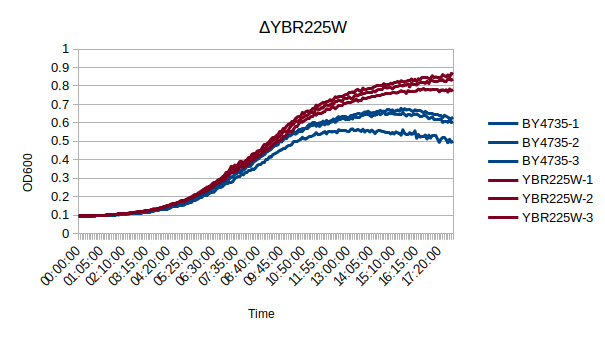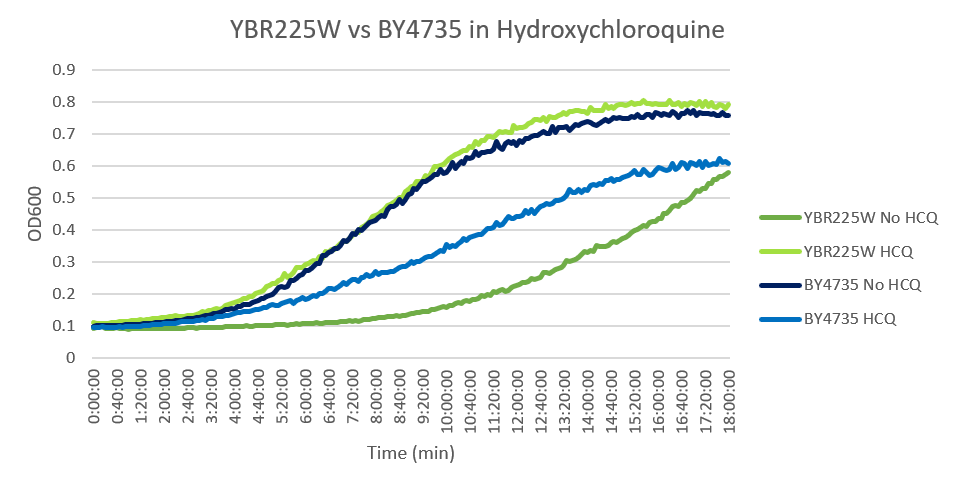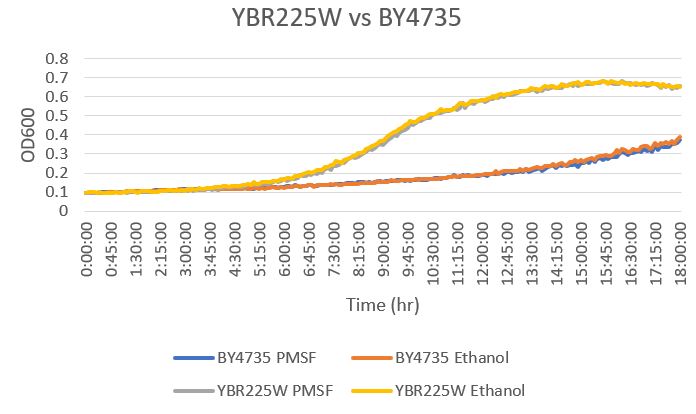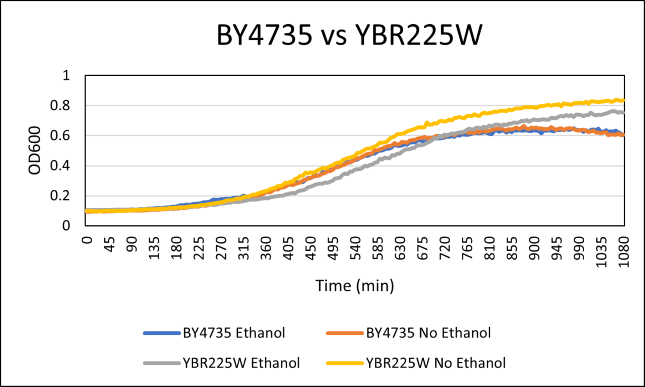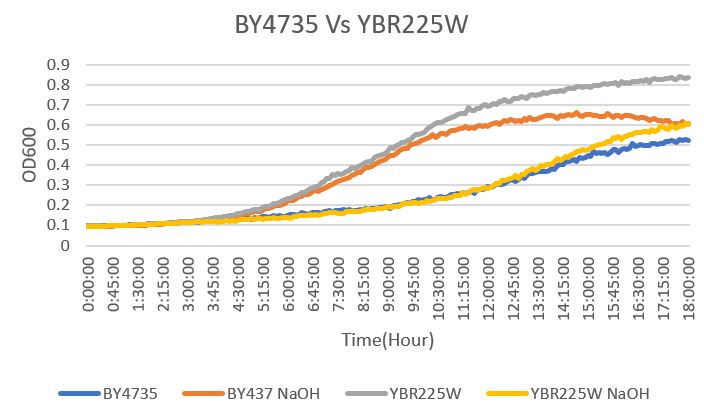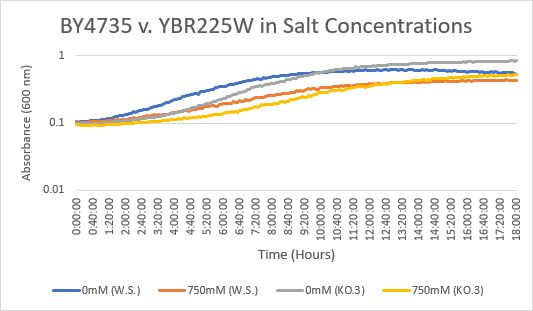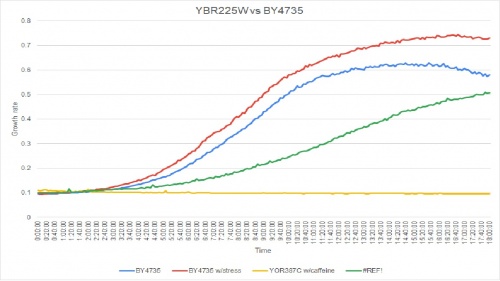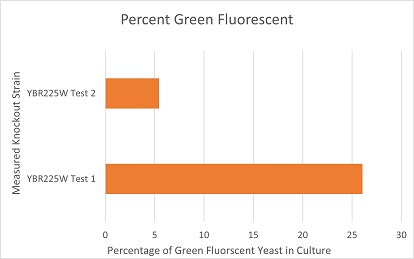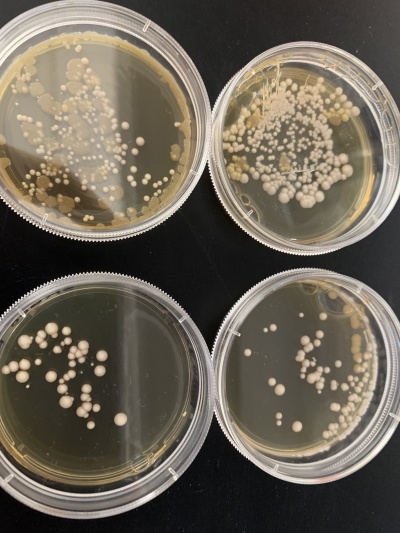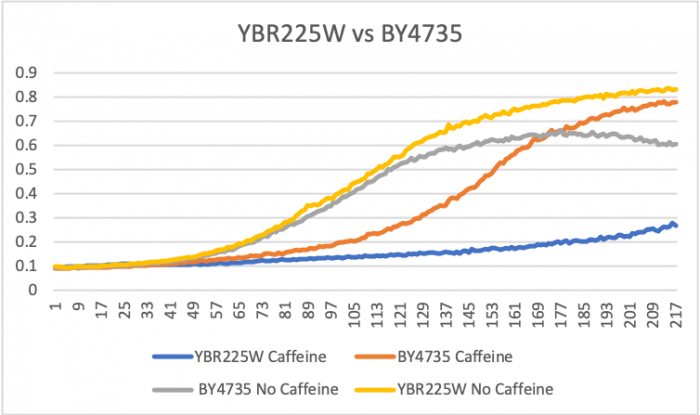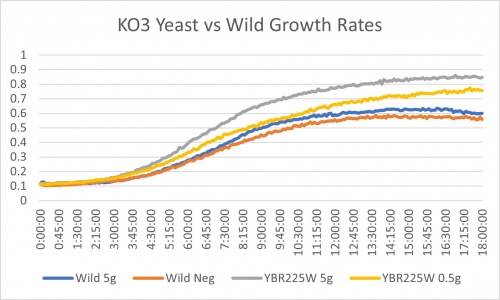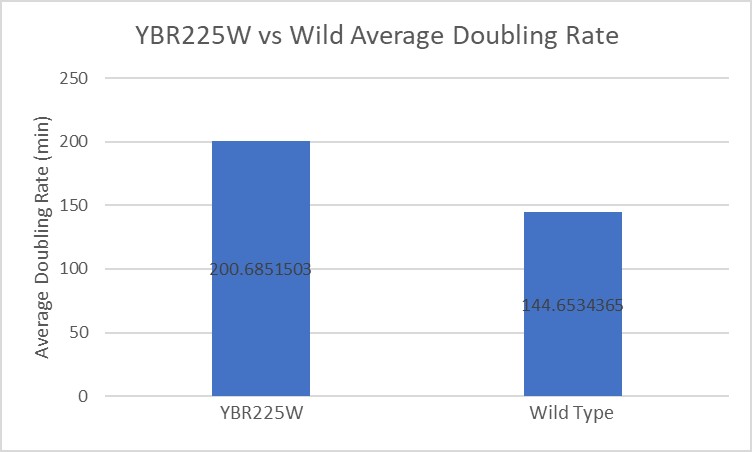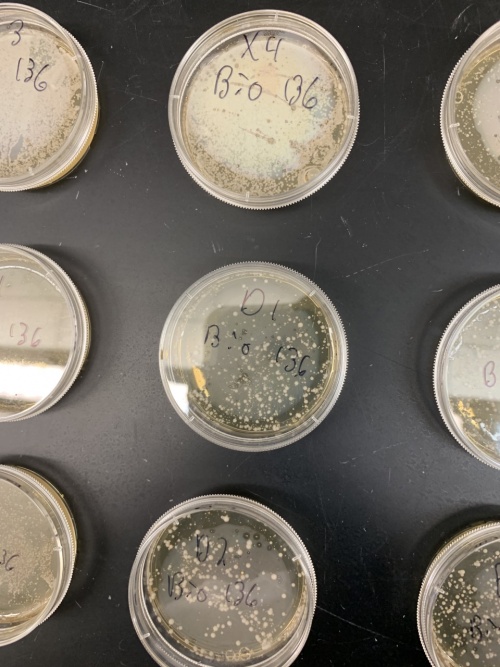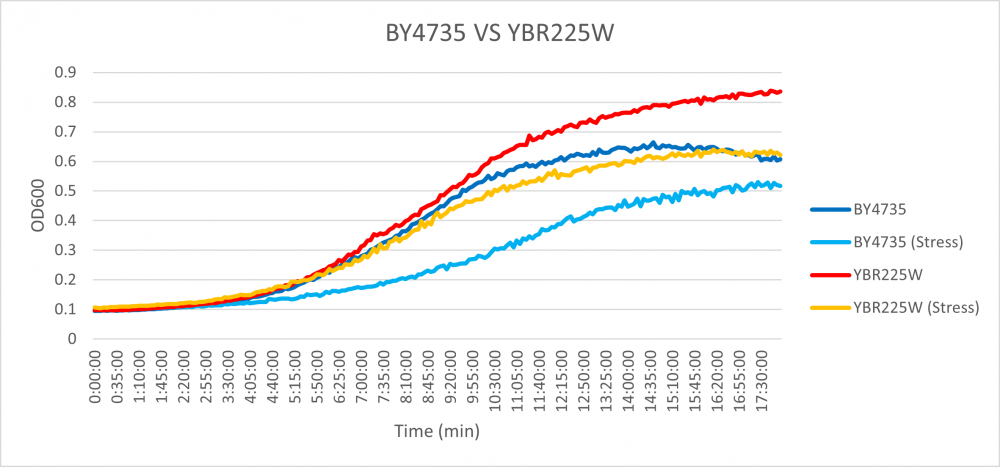Difference between revisions of "YBR225W"
(→Ethanol Sensitivity) |
(→Caffeine Group 2) |
||
| (24 intermediate revisions by the same user not shown) | |||
| Line 50: | Line 50: | ||
The YBR225W yeast gene strain was noted to have a different growth rate than the BY4735 when exposed to PMSF. The YBR225W was determined to have an average doubling time of 183 minutes, while the BY4735 strain had a doubling time of 382 minutes. It is likely that the YBR225W yeast strain has a higher resistance to drugs such as PMSF, which catalyzes cell lysis. The doubling time of the YBR225W when exposed to ethanol was calculated to be 156 minutes, and the BY4735 yeast strain was noted to be 442 minutes. | The YBR225W yeast gene strain was noted to have a different growth rate than the BY4735 when exposed to PMSF. The YBR225W was determined to have an average doubling time of 183 minutes, while the BY4735 strain had a doubling time of 382 minutes. It is likely that the YBR225W yeast strain has a higher resistance to drugs such as PMSF, which catalyzes cell lysis. The doubling time of the YBR225W when exposed to ethanol was calculated to be 156 minutes, and the BY4735 yeast strain was noted to be 442 minutes. | ||
| + | |||
| + | ===[[UW-Stout/Ethanol_Sensitivity_SP21|Ethanol Sensitivity]]=== | ||
| + | [[File:YBR225W Ethanol.png]] | ||
| + | |||
| + | The yeast strain YBR225W does not seem to effect the growth rate as the BY4735 when exposed to a 9% ethanol concentration had very similar growth curves. The YBR225W was determined to have an average doubling time of 188 minutes, while the BY4735 strain had a doubling time of 182 minutes. It is likely that the YBR225W yeast strain has a similar resistance to ethanol concentrations as the doubling time of the YBR225W when exposed to ethanol was calculated to be 225 minutes, and the BY4735 yeast strain was noted to be 217 minutes. | ||
| + | |||
| + | [[https://wiki.yeastgenome.org/index.php/UW-Stout/Ethanol_SP21]] | ||
| + | |||
===[[UW-Stout/Sodium Hydroxide SP21|Sodium Hydroxide]]== | ===[[UW-Stout/Sodium Hydroxide SP21|Sodium Hydroxide]]== | ||
[[File:YBR VS WT.jpg]] | [[File:YBR VS WT.jpg]] | ||
| Line 111: | Line 119: | ||
Like the plates for YKL121W, these plates had some contamination with the 0sec plates having more than the 600sec plates likely because the UV played a part in killing some of the contamination. Both plates seemed to show a 70% difference. I don't believe this is strong enough to imply that the knocked-out gene was related to UV light. | Like the plates for YKL121W, these plates had some contamination with the 0sec plates having more than the 600sec plates likely because the UV played a part in killing some of the contamination. Both plates seemed to show a 70% difference. I don't believe this is strong enough to imply that the knocked-out gene was related to UV light. | ||
---- | ---- | ||
| − | ===[[UW-Stout/ | + | ===[[UW-Stout/Caffeine 2 SP21|Caffeine Group 2]]=== |
| − | [[File:YBR225W | + | [[File:YBR225W graph.png|700px]] |
====Doubling Time at 0.25 concentration==== | ====Doubling Time at 0.25 concentration==== | ||
| − | YBR225W Td = (199-1) x ln(2)/ln(0.25/0.1) = 150 minutes; Wild Type Td = (146-66) x ln(2)/ln(.6/.2) = 88 minutes | + | YBR225W Td = (199-1) x ln(2)/ln(0.25/0.1) = 150 minutes; Wild Type Td = (146-66) x ln(2)/ln(.6/.2) = 88 minutes; YBR225 no caffeine Td= (145-41) x ln(2)/ln(.7/.1)= 37 minutes; |
| − | + | These doubling times show that the 0.25 mM concentration in YBR225W slowed down the rate of growth. The caffeine was able to slow down metabolic activity. Caffeine may effect the function of the Rad52 protein that aids in DNA double-stranded breaks and maintaining genome stability. The caffeine may also aid in the process of the cell protecting itself from reacting oxygen species. Since the concentration is small in volume, apoptosis was not induced for cell function. | |
==[[UW-Stout/Ammonium_Sulfate_SP21|Ammonium Sulfate]]== | ==[[UW-Stout/Ammonium_Sulfate_SP21|Ammonium Sulfate]]== | ||
| Line 132: | Line 140: | ||
The YBR225W yeast gene was effected by the heat shock experiment. It was difficult to get exact data being that there were many colonies to count in each plate, but it is easy to see that there were significantly less colonies on this genes heat shock plate compared to the non-heat shock plate. This gene's DNA colonies were much larger than the controlled plate's, but had fewer colonies at the same time. | The YBR225W yeast gene was effected by the heat shock experiment. It was difficult to get exact data being that there were many colonies to count in each plate, but it is easy to see that there were significantly less colonies on this genes heat shock plate compared to the non-heat shock plate. This gene's DNA colonies were much larger than the controlled plate's, but had fewer colonies at the same time. | ||
| + | |||
| + | |||
| + | == Hydroxyurea == | ||
| + | [[File:YBR.png|center|1000px|]] | ||
| + | |||
| + | The YBR225W strain was to have an average doubling time of 189 minutes, which was slightly higher than the doubling time of the BY4735 strain, with 182 minutes. The doubling time of the BY4735 strain when exposed to hydroxyurea was 289 and a half minutes and the doubling time of the YOR387C strain 223 minutes. Hydroxyurea seems to impact these strains slightly in terms of being more sensitive to this stress, but overall not a drastic impact, although the YBR225W strain seems to grow faster in rate than the wild type strain. | ||
| + | [https://wiki.yeastgenome.org/index.php/UW-Stout/Hydroxyurea_SP21] | ||
==References== | ==References== | ||
| Line 137: | Line 152: | ||
{{RefHelp}} | {{RefHelp}} | ||
</protect> | </protect> | ||
| − | |||
| − | |||
| − | |||
| − | |||
| − | |||
Latest revision as of 07:09, 5 May 2021
Share your knowledge...Edit this entry! <protect>
| Systematic name | YBR225W |
| Gene name | |
| Aliases | |
| Feature type | ORF, Uncharacterized |
| Coordinates | Chr II:670627..673329 |
| Primary SGDID | S000000429 |
Description of YBR225W: Putative protein of unknown function; non-essential gene identified in a screen for mutants affected in mannosylphophorylation of cell wall components[1][2]
</protect>
Contents
Community Commentary
About Community Commentary. Please share your knowledge!
This gene is part of the UW-Stout Orphan Gene Project. Learn more here.
Growth Curve
In a BY4735 background, knocking out YBR225W does not seem to have any effect on the strain's growth rate. In this assay, the BY4735 strain's doubling time was 162 minutes, while the YBR225W knock-out strain's doubling time was 156 minutes. (These doubling times are the means of three experiments.)
Hydroxychloroquine
HCQ refers to hydroxychloroquine
Under normal conditions, the BY4735 doubling time is 144 minutes, while that of YBR225W is 236 minutes. Thus, YBR225W doubles slower than the wild strain. When grown in an environment with hydroxychloroquine, YBR225W doubled in 191 minutes, while BY4735 doubled in 276 minutes. Surprisingly, YBR225W doubling time decreased in hydroxychloroquine, which suggests that it grew faster in the presence of hydroxychloroquine. It is also evident that the lag phase of YBR225W shortened with the addition of hydroxychloroquine. The BY4735 strain was inhibited by hydroxychloroquine. (These doubling times and curves are the means of three experiments.)
Phenylmethylsulphonyl Fluoride
The YBR225W yeast gene strain was noted to have a different growth rate than the BY4735 when exposed to PMSF. The YBR225W was determined to have an average doubling time of 183 minutes, while the BY4735 strain had a doubling time of 382 minutes. It is likely that the YBR225W yeast strain has a higher resistance to drugs such as PMSF, which catalyzes cell lysis. The doubling time of the YBR225W when exposed to ethanol was calculated to be 156 minutes, and the BY4735 yeast strain was noted to be 442 minutes.
Ethanol Sensitivity
The yeast strain YBR225W does not seem to effect the growth rate as the BY4735 when exposed to a 9% ethanol concentration had very similar growth curves. The YBR225W was determined to have an average doubling time of 188 minutes, while the BY4735 strain had a doubling time of 182 minutes. It is likely that the YBR225W yeast strain has a similar resistance to ethanol concentrations as the doubling time of the YBR225W when exposed to ethanol was calculated to be 225 minutes, and the BY4735 yeast strain was noted to be 217 minutes.
[[1]]
=Sodium Hydroxide
The YBR225W yeast gene strain has been seen to have a different growth rate than the BY4735 when both are exposed to NaOH. The YBR225W has an average doubling time of 556 minutes, while the BY4735 strain had a doubling time of 545 minutes. It is likely that the YBR225W gene is more resistant to NaOH than BY4735. When just exposed to water, YBR225W had a doubling time of 691 minutes and BY4735 had a doubling time of 809 minutes.
Salt Concentration (NaCl)
0mM NaCl conc. BY4735 strain's doubling time: 169 minutes
0mM NaCl conc. YBR225W strain's doubling time: 224 minutes
750mM NaCl conc. BY4735 strain's doubling time: 294 minutes
750mM NaCl conc. YBR225W strain's doubling time: 226 minutes
The graph above shows the growth rate for the previously listed strains and the relative level of NaCl concentration. Knocking out the gene negatively impacted the growth rate. Comparing the YBR225W doubling times in 0mM and 750mM NaCl, there is a no effect on the growth rate. This effect has no influence on the knockout strain's (YBR225W) growth.
Caffeine Group 1
When adding caffeine to the YBR225W strain the growth rate had a huge effect. The doubling time of the strains were as followed:
Doubling time of YBR225W with caffeine: 296 minutes
Doubling time of YBR225W without caffeine: 208 minutes
Doubling time of BY4735 with caffeine: 138 minutes
Doubling time of BY4735 without caffeine: 187 minutes
The effect that the caffeine had on the YBR225W knockout strain increased the doubling time. The effect was detrimental to the yeast and it didn't grow.
Competative Co-culture
These are the results of a competitive co-culture protocol. The knockout strain was grown in a culture to test fitness against a green, fluorescent wild-type strain. The percentage of analyzed cells in the culture measured was those displaying green fluorescence. In theory, this should mean if a knockout has reduced the fitness of a strain of yeast, the fluorescent wild-type strain would have a higher percentage than the knockout strain. If the knockout does not decrease fitness, they would be roughly equal. This may not be so in results. Sources of error may include contamination and human error.
The results here are not expected. It was not readily apparent this knockout strain grew quickly, so more likely than not, both tests were contaminated with an organism that grows faster than yeast and does not display a fluorescent trait like the wild-type.
UV Light
Results:
- Experiment 1:0sec=373 colonies, 600sec=107 colonies.
- Experiment 2:0sec=157 colonies, 600sec=47 colonies.
Interpretation: The two 0sec plates are on top and the 600sec plates are on the bottom. Like the plates for YKL121W, these plates had some contamination with the 0sec plates having more than the 600sec plates likely because the UV played a part in killing some of the contamination. Both plates seemed to show a 70% difference. I don't believe this is strong enough to imply that the knocked-out gene was related to UV light.
Caffeine Group 2
Doubling Time at 0.25 concentration
YBR225W Td = (199-1) x ln(2)/ln(0.25/0.1) = 150 minutes; Wild Type Td = (146-66) x ln(2)/ln(.6/.2) = 88 minutes; YBR225 no caffeine Td= (145-41) x ln(2)/ln(.7/.1)= 37 minutes; These doubling times show that the 0.25 mM concentration in YBR225W slowed down the rate of growth. The caffeine was able to slow down metabolic activity. Caffeine may effect the function of the Rad52 protein that aids in DNA double-stranded breaks and maintaining genome stability. The caffeine may also aid in the process of the cell protecting itself from reacting oxygen species. Since the concentration is small in volume, apoptosis was not induced for cell function.
Ammonium Sulfate
YBR225W gene does not indicate any difference from the wild strain when starving of nitrogen. We know this because in the wild it shows 17.8% slower growth when completely removing ammonium sulfate from the media and comparing that to the full amount of 5g/ml. While in YBR225W it shows 18.1%. These are more or less the same indicating that this gene does not make the yeast more or less sensitive to nitrogen starvation.
Calcofluor White
From this data we can determine that there was significant growth inhibition on this strain of yeast. The modified yeast had a doubling rate that was fifty-six minutes slower than the wild type on average, and when compared to the effect on other yeast strains this is a large change in the average doubling rate.
Heat Shock
The YBR225W yeast gene was effected by the heat shock experiment. It was difficult to get exact data being that there were many colonies to count in each plate, but it is easy to see that there were significantly less colonies on this genes heat shock plate compared to the non-heat shock plate. This gene's DNA colonies were much larger than the controlled plate's, but had fewer colonies at the same time.
Hydroxyurea
The YBR225W strain was to have an average doubling time of 189 minutes, which was slightly higher than the doubling time of the BY4735 strain, with 182 minutes. The doubling time of the BY4735 strain when exposed to hydroxyurea was 289 and a half minutes and the doubling time of the YOR387C strain 223 minutes. Hydroxyurea seems to impact these strains slightly in terms of being more sensitive to this stress, but overall not a drastic impact, although the YBR225W strain seems to grow faster in rate than the wild type strain. [2]
References
See Help:References on how to add references
See Help:Categories on how to add the wiki page for this gene to a Category </protect>
